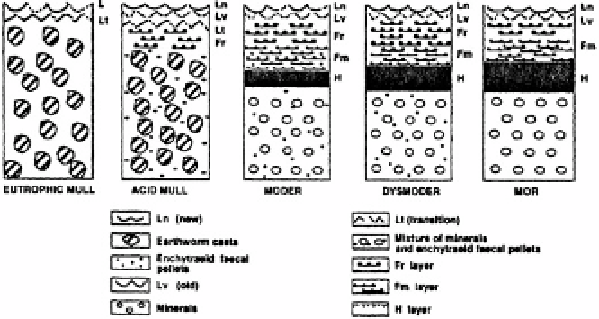Agriculture Reference
In-Depth Information
The H layer is principally an accumulation of the smaller faecal pellets of micro-
arthropods and Enchytraeidae‚ and amorphous decomposing fungal material. This layer
may in turn be subdivided into an Hr in which plant remains may still be identified‚
and an Hf layer in which plant remains are no longer identifiable and are admixed with
mineral materials.
Layer thickness may differ considerably depending on the type of litter system
(Figure IV.16). In mulls‚ the litter system is restricted to an L layer comprising leaves
aged less than one year. A notable exception to this is acid mull litters that develop in
the absence of anecic earthworms through the intense activity of white-rot basidiomycote
fungi; where this occurs‚ the L layer may be substantially thicker and consist of slowly
decomposing leaves accumulated over the previous 2-3 years (Toutain‚ 1974).
In moders‚ the L layer is often subdivided into Ln and Lv sublayers to distinguish new
(n) and old (v) leaves (Brun‚ 1978). The F layer is the most developed and may
be several centimetres deep with well defined Fr and Fm layers. In tropical moders‚
the H layer can be colonised by a dense root mat that may be 10-30 cm thick in extreme
situations (Cuevas and Medina‚ 1988; Jordan‚ 1989; Leroy
et al
.‚ 1992). In more‚ the
litter system is thick and the H layer is often fibrous and composed of humified fungal
and other materials.
Meso- and microscale features
At a finer scale of resolution‚ microscopic observations of litter layers may indicate their
composition and structure. Anderson (1977) made a detailed description of microstructures
within the L‚ F and H layers of a moder litter in an English Chestnut (
Castanea sativa)
forest. Twenty-three different structural units were recognised and quantified on sections
of the litter system embedded in gelatine (Table IV.3). A positive correlation was found


